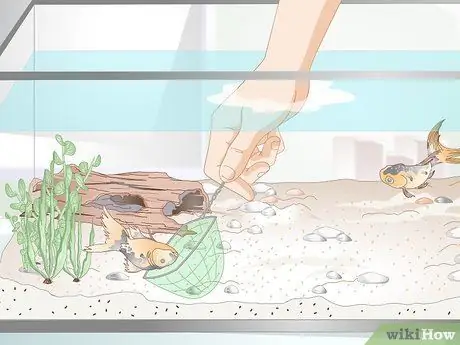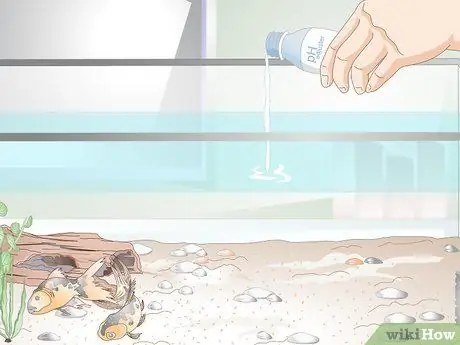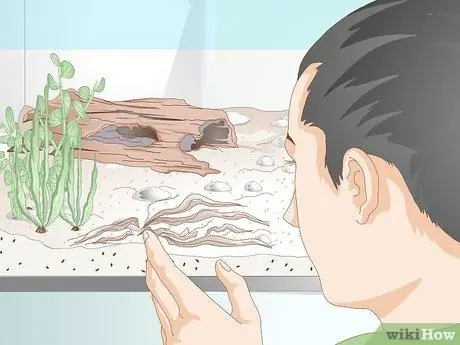- Author Jason Gerald [email protected].
- Public 2023-12-16 10:50.
- Last modified 2025-01-23 12:04.
Ammonia is highly toxic to fish and other aquatic animals. A safe level of ammonia is only 0 parts per million (ppm). Even concentrations as low as 2 ppm can cause fish to die in your aquarium. By testing your aquarium water and making the necessary adjustments, you can help bring your ammonia levels back down to a level that is safe and acceptable for your fish.
Step
Part 1 of 3: Lowering Ammonia Levels in Fish Aquarium

Step 1. Perform a partial water change
Partial water changes are an efficient and excellent way to reduce ammonia levels and keep the aquarium clean for your fish. Try to do a partial water change about once a week, although you may need to do it more often, depending on the conditions of the tank. A good way to check if you need to do more frequent partial replacements is to stir the gravel at the bottom of the tank with a fishing net. If there's a lot of floating debris, it's a sign that you're not changing the water often enough.
- Let the new water sit overnight to dechlorinate, or treat the water with a dechlorinating product.
- Wash your hands and make sure you wash off any residue from soap, lotion, and other potential contaminants. Dry your hands with clean tissue paper.
- Unplug electrical equipment that is near the aquarium to prevent the risk of accidental electrocution. Wait to plug in the equipment until you are done with the water change and make sure everything is dry.
- On the other hand, for a healthy aquarium, you can aim to replace about 30% of the water. In a 38 liter aquarium, that means replacing 12 liters of water.
- You don't need to move the fish to do a partial water change. You just need to be careful when you put your hands in the tank so you don't startle the fish.
- Scrape off any algae growing on the walls of the aquarium. You can buy a special tool for scraping algae, or just use an unused credit card.
- Use a siphon hose to drain 30% of the old water into a nearby bucket or sink. When you've drained enough of the old water, slowly pour in the new, dechlorinated water.

Step 2. Remove any organic matter that shouldn't be in the aquarium
Decomposing organic matter is an important factor in increasing ammonia levels. By using a fishing net to pick up anything that shouldn't be there (basically, anything but fish and plants you want in your tank), you can lower ammonia levels and prevent them from rising.
- Uneaten feed is the biggest contributor to ammonia levels.
- Fish droppings can also cause a spike in ammonia levels when it breaks down.
- Dead plants or dead fish in the tank will emit large concentrations of ammonia.
- Try cleaning the filter in your tank, as this can introduce organic matter back into the water. However, do not replace the filter pads to maintain the balance of bacteria in the water.

Step 3. Reduce the frequency and quantity of food given
If your fish leave a lot of food uneaten, it could be the reason for your aquarium's ammonia levels to rise. By reducing the available food in the tank, you will reduce the chances of ammonia levels rising.
- Make sure your fish are getting enough food. Talk to your veterinarian or fishery expert about the amount of food your fish need to stay healthy.
- Be aware that changing your fish feeding habits will not reduce already high ammonia levels; however, this will prevent future spikes in ammonia levels when the water has been replaced.

Step 4. Add good bacteria to the water
The bacterial colonies that normally line the bottom of an established fish tank help convert ammonia to a relatively benign component of nitrogen. If your aquarium is new or your bacterial colonies have drastically reduced, you may be experiencing what some fishery experts call "new aquarium syndrome."
- Some people add bacteria by putting a cheap fish or two into the tank so that the fish droppings can carry the bacteria. If you try this method, you can use goldfish for cold water tanks, barbs for warm water tanks, or damsels for saltwater aquariums.
- You can also add good bacteria by adding a handful of gravel from an older fish tank to the bottom of your new fish tank.

Step 5. Lower the pH of the aquarium
Ammonia occurs in the un-ionized form as NH3 or ionized as ammonium (NH4+). Un-ionized ammonia (NH3) is toxic to fish, and is generally at its highest concentration when the pH of the water is alkaline (high values on the pH scale).
- Adding a chemical pH regulator (from your local pet store) is probably the easiest way to lower the pH of your aquarium.
- Lowering the pH won't remove the ammonia, but it can reduce the level of danger if you need time before you can change the water.
- One easy way to keep the pH low is to make sure you use real gravel for the substrate (bottom) of your fish tank. Using crushed rock or coral sand releases calcium into the water which can cause a pH spike.

Step 6. Try adding water aeration
NH3, the toxic form of ammonia, is a gaseous solution that absorbs water. By increasing the aeration of the aquarium water, you may be able to help disperse the ammonia gas out of the water into the air.
- Aeration won't have much effect on large ponds, but it can help regulate ammonia levels in your fish tank.
- You can buy an aeration pump at most pet stores or online.
- Make sure you leave the tank uncovered if the lid is normally attached. As the ammonia gas spreads, it must be able to move outside the aquarium.

Step 7. Use neutralizing drops
One way to temporarily improve ammonia levels in the aquarium is to use neutralizing drops. You can buy this medication at most pet stores, or order it online.
- Neutralizing drops don't actually remove ammonia from the water. However, these drops will neutralize the toxic effects of ammonia, turning it harmless in water.
- You will still need biological filtration (using bacteria) to break down ammonia into nitrites and nitrates.
Part 2 of 3: Identifying Sources of High Ammonia Levels

Step 1. Check the tap water
Tap water containing very high levels of ammonia is a relatively rare occurrence. Most municipal water systems test concentrations of chemicals such as ammonia to ensure the water is safe to drink (especially outside Indonesia). Even so, there's no harm in checking if you've done everything else right and the ammonia levels aren't dropping.
- Use an ammonia test kit that you can use in your fish tank to test your tap water.
- If your tap water's ammonia level is high, report it to your local municipal water manager.

Step 2. Look for spoilage in the aquarium
Decaying material in an aquarium is one of the biggest causes of high ammonia levels. By evaluating the water content of the aquarium, you will have a clearer idea of what needs to be done to fix the problem.
- Any decaying organic matter, including microorganisms and aquatic plants, can cause a spike in ammonia levels as protein breaks down.
- Uneaten feed can also cause a spike in ammonia levels as it decomposes in the water.
- Get rid of any material that shouldn't be in the tank as soon as possible. Make sure you follow your regular aquarium replacement schedule or perform a partial water change.

Step 3. Identify the ammonia your fish excrete
If you see a lot of fish droppings floating in the tank, it could be a source of rising ammonia levels. Your fish droppings will gradually break down, much like decaying organic matter, causing ammonia levels to rise in the water.
You can deal with fish waste by removing solids whenever you see them and changing or performing partial aquarium water changes on a regular basis
Part 3 of 3: Taking Accurate Ammonia Measurements

Step 1. Purchase a standard test kit
Most pet stores sell ammonia testing kits. This device tests the amount of ammonia (including ammonia and ammonium) levels. The problem with this is that the test doesn't differentiate between levels of both types of ammonia, which means you can't accurately judge how toxic the aquarium water is.
- As a general rule, if your aquarium is well established (it's already populated and has active bacterial colonies), you shouldn't find any ammonia with a standard test kit.
- If this test shows detectable levels of ammonia and you know for sure that there are colonies of good bacteria and no organic matter, the problem may be with your filter.

Step 2. Measure the pH of the water
The pH level of your aquarium can directly affect the level of ammonia in the water. By measuring pH regularly, you will help ensure that ammonia levels are non-toxic.
- The pH of the water affects the amount of ammonia that is ionized compared to the amount of non-ionized ammonia.
- You'll still need to do some maintenance on the water beyond adjusting the pH, as acidifying the water won't actually break down the ammonia that's already there.

Step 3. Test the water at the right time
Depending on when you test the aquarium water, you may get an incorrectly high result. The best time to test the water is right before feeding, since the new food hasn't decomposed in the water.
- Ammonia levels reach their peak about 90 minutes after the fish are fed.
- Testing the water just after the fish has eaten (and is excreting) may give inaccurate results of a high ammonia level test.
Tips
- Make sure you don't overcrowd the tank with too many fish.
- Don't overfeed the fish, and make sure the aquarium has good filtration.
- Make sure you circulate the new aquarium before adding fish.






